
Rhodonite vs. Rhodochrosite: What’s The Difference?
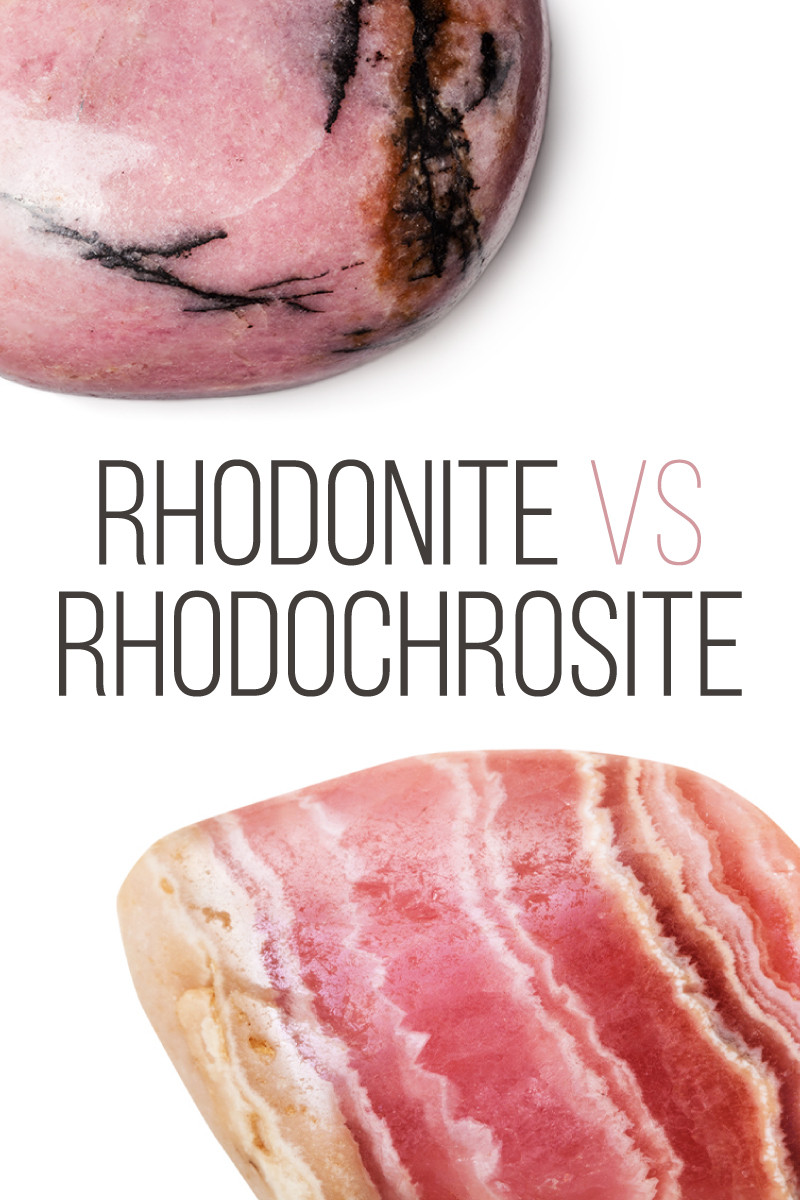 Many gemstone names come from similar Greek or Latin root words, which can lead to confusion between similar-sounding gems. Prime example? Rhodonite vs. rhodochrosite.
Many gemstone names come from similar Greek or Latin root words, which can lead to confusion between similar-sounding gems. Prime example? Rhodonite vs. rhodochrosite.
Are rhodochrosite and rhodonite the same? No, but we wouldn’t blame you for thinking so. If the names weren’t similar enough, these colored gemstones also share a similar appearance.
In this guide, we’ll teach you every difference between rhodochrosite and rhodonite gemstones. By the end, you’ll know all the factors, monetary and spiritual factors included, to confidently shop for rhodochrosite and rhodonite!

What Are Rhodonite and Rhodochrosite?
Rhodonite and rhodochrosite are both pink gemstones. Fittingly, both names derived from Greek words for “rose” in reference to their color.
Rhodonite comes from rhodon (or ρόδον in Greek) for “rose-red.” Rhodochrosite comes from rhodos (or ρόδο in Greek) for “rose” and khros (or χρώς in Greek) for “colored.”
Before you can tell them apart, you’ll need to know the basics.
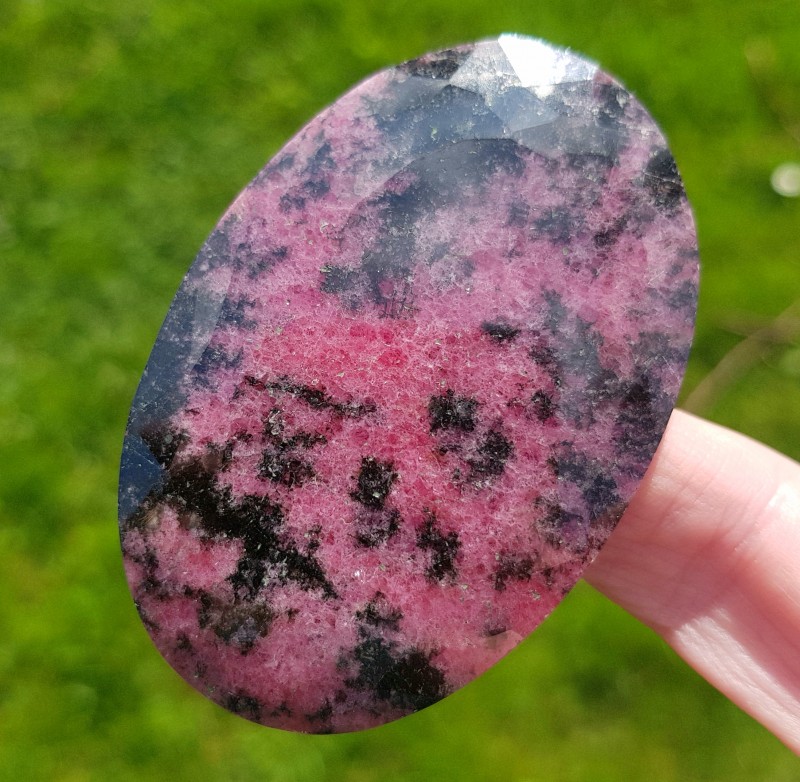 Image: Rhodonite
Image: Rhodonite
First, what is rhodonite?
Rhodonite (pronounced ro-duh-nite) is a transparent to translucent, sometimes opaque, manganese silica stone, often with calcium, manganese, and iron inside as well.
This gem is known for being the state gemstone of Massachusetts, USA, and a national symbol of Russia (its first and most prolific source).
How do you identify rhodonite?
These stones are typically pink, rosy-red, or crimson, but can be orange or brownish-red sometimes. Rhodonite can also display weak yellow-red to pink-red pleochroism and on occasion, chatoyancy (the “cat’s eye” effect).
Different levels of certain elements in the stone, often as inclusions, can lead to different rhodonite varieties. For example, zinc and calcium mixed in can create the pale pink fowlerite, while high levels of calcium can form the mauve-colored Hsihutsunite from China.
The most obvious clue that a gem is rhodonite is the dark portions. Due to manganese oxide inclusions, the stone has uneven bands, veins, or color zones in dark brown, gray, or black.
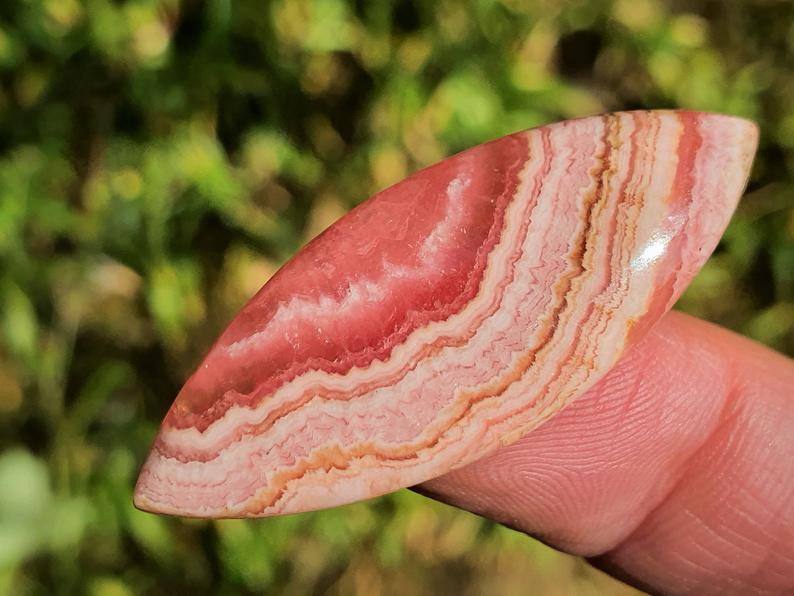 Image: Rhodochrosite
Image: Rhodochrosite
Now, what is rhodochrosite?
Rhodochrosite (pronounced row-duh-krow-site) is a typically translucent manganese carbonate stone with rich, vibrant coloring.
Where is rhodochrosite found? Arguably the best crystals come from Colorado, USA, where rhodochrosite is the state gemstone. Argentina and South Africa produce top-quality specimens as well. Nicknamed “Inca Rose” or “Rosa del Inca” in South America, rhodochrosite is also Argentina’s national gemstone.
The stone may have varying levels of elements like calcium, zinc, iron, or cobalt. Therefore, some rhodochrosite properties may vary as well — namely, its color.
Rhodochrosite crystals can be pink, red, brown, orangish, gray, yellow, or even yellowish-gray. Pure rhodochrosite is raspberry to pink.
There are two main varieties:
Banded Rhodochrosite: Most common variety that’s translucent to opaque with striped or circular veins resembling malachite's banding
Solid Rhodochrosite: Rare translucent to transparent type with great clarity and a single color throughout
 Image: Solid-colored rhodochrosite
Image: Solid-colored rhodochrosite
Banded rhodochrosite usually has a light to hot pink base and jagged veins or bands. Does rhodochrosite have black in it? No, rhodochrosite’s bands are varied shades of pink with white, light gray, or tan bands between.
With the foundational knowledge of each stone down, what's the difference between rhodochrosite and rhodonite?
Characteristics: Similarities & Differences
Let’s start with how rhodochrosite and rhodonite are similar. For one, manganese is fundamental to each stone’s chemical make-up. They’re also both rare gems named in the 1810s by German mineralogists.
Rhodonite is a semi-precious gem, but is rhodochrosite a semi-precious stone? Yes, rhodochrosite is also a semi-precious gemstone.
The next similarity is, of course, color. Not only are both stones pink, but they can also both show shades of brown, yellow, red, and gray. Plus, they’re each commonly color-banded.
Some more properties they have in common are:
Luster: Vitreous to pearly
Transparency: Transparent to opaque
Cleavage: Perfect
Density: 3.5-3.7
Fracture: Uneven to conchoidal
Pleochroism: Sometimes; Weak
Common Inclusions: Calcium, iron, zinc
Onto the more important side: the differences!
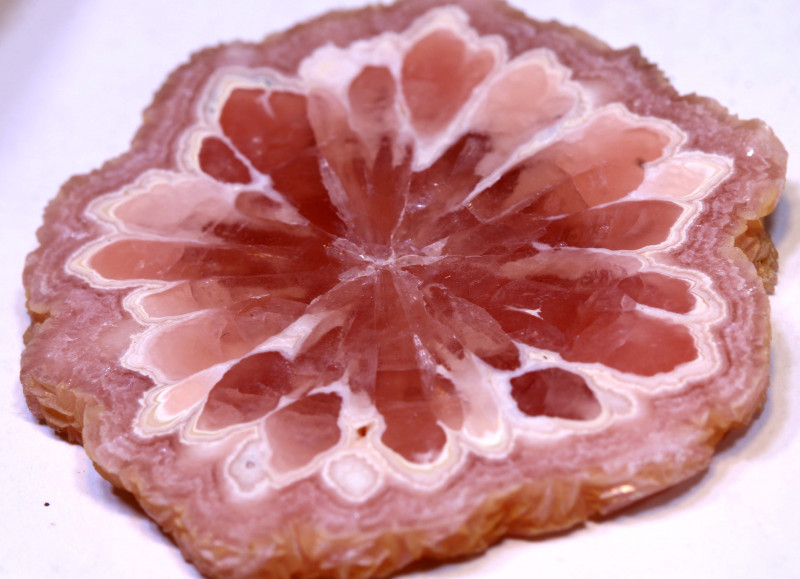
Differences Between Rhodochrosite and Rhodonite
The most obvious difference is rhodonite and rhodochrosite’s color patterns. Rhodonite has dark-colored, uneven bands or zones, but rhodochrosite has light-colored, mostly parallel color banding.
While both stones have perfect cleavage, the cleavage directions and shapes differ. Rhodonite’s cleavage is 2-directional and prismatic, while rhodochrosite’s cleavage is 3-directional and rhombohedral.
We’ll list the rest of rhodochrosite and rhodonite’s differing properties below, with rhodonite’s values listed first and rhodochrosite’s listed second (rhodonite value vs. rhodochrosite value):
Composition: Manganese silicate vs. manganese carbonate
Hardness: 5.5-6.5 vs. 3.5-4
Crystal Structure: Triclinic vs. trigonal
Refractive Index: 1.71-1.75 vs. 1.58-1.82
Fluorescence: Always present vs. sometimes present
Chatoyancy: May be present vs. never present
Pleochroism: Pinkish-red to yellowish-red vs. pale pink to pinkish-red or colorless
Lastly, the effect of oxidation on either stone is a major distinction.
When manganese oxide in rhodonite takes up most of the stone, rusting over time can make the entire gem look black. Only some varieties of rhodochrosite will oxidize over time (from iron inclusions), but the effect is a darker pink hue.
Many of the differences listed above would be difficult to know without gemstone expertise. Next, we’ll break down some ways to identify rhodonite vs. rhodochrosite that even the freshest novice can try!
How Can You Tell The Difference Between Rhodochrosite And Rhodonite?
The easiest field indicators for identifying these stones are color-banding, hardness, and reaction to acid.
 Image: Rhodonite cabochon
Image: Rhodonite cabochon
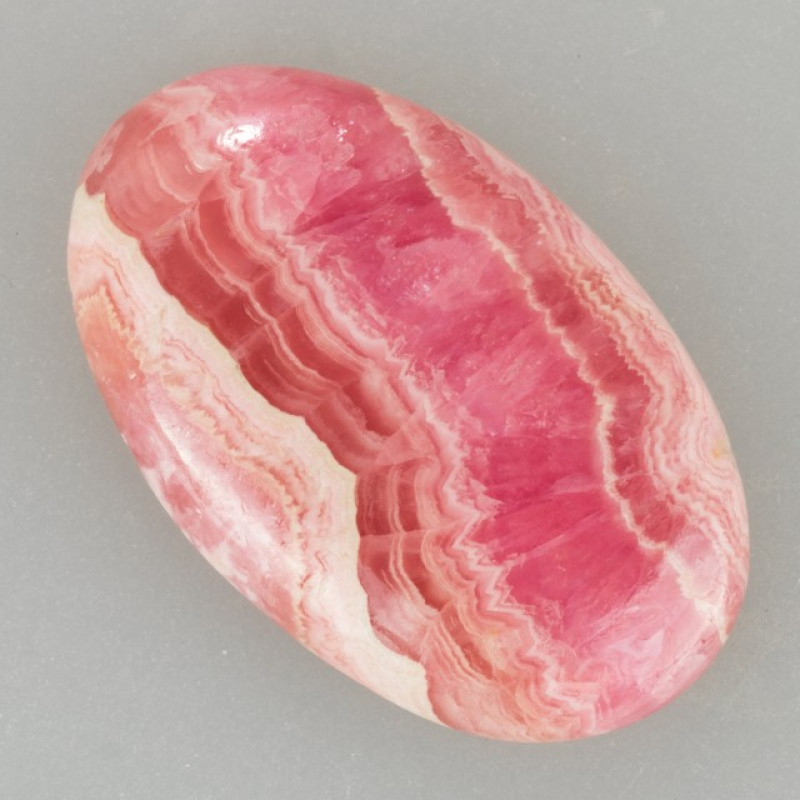
Image: Rhodochrosite cabochon
Remember Color-Banding
You know now that rhodonite and rhodochrosite’s dark and light banding, respectively, is a major distinguisher. But how can you remember which one has which banding?
Think of the darkness of “night” for rhodo-nite’s dark-colored banding. For rhodochrosite, you can think of “cream” with “chrosite” to remember its creamy, light-colored banding.
Test Hardness
Hardness describes a stone’s relative resistance to scratching, measured on the Mohs mineral hardness scale. Rhodonite hardness is 5.5-6.5, and rhodochrosite hardness is 3.5-4. If you have both stones, rhodonite will scratch rhodochrosite easily.
Rhodonite alone will scratch gems like apatite, fluorite, and calcite. On the other hand, rhodochrosite can only scratch calcite, gypsum, or talc (the lowest stones on the Mohs scale).
Test Reaction to Acid
One of rhodochrosite’s unique traits is its reaction to hydrochloric acid. In diluted hydrochloric acid, the stone will slowly effervesce (fizz with small bubbles) and then begin dissolving. The effect is more apparent if the acid is warm.
Rhodonite, on the other hand, won’t react to acid.
Hydrochloric acid is a dangerous substance if used incorrectly or without safety precautions, so only use this test with proper supervision and expertise. Moreover, we only recommend it for field specimens, as you wouldn’t want to try dissolving any beautiful jewelry or decor.
For buyers interested in these gems, how much does rhodochrosite cost? What about rhodonite?
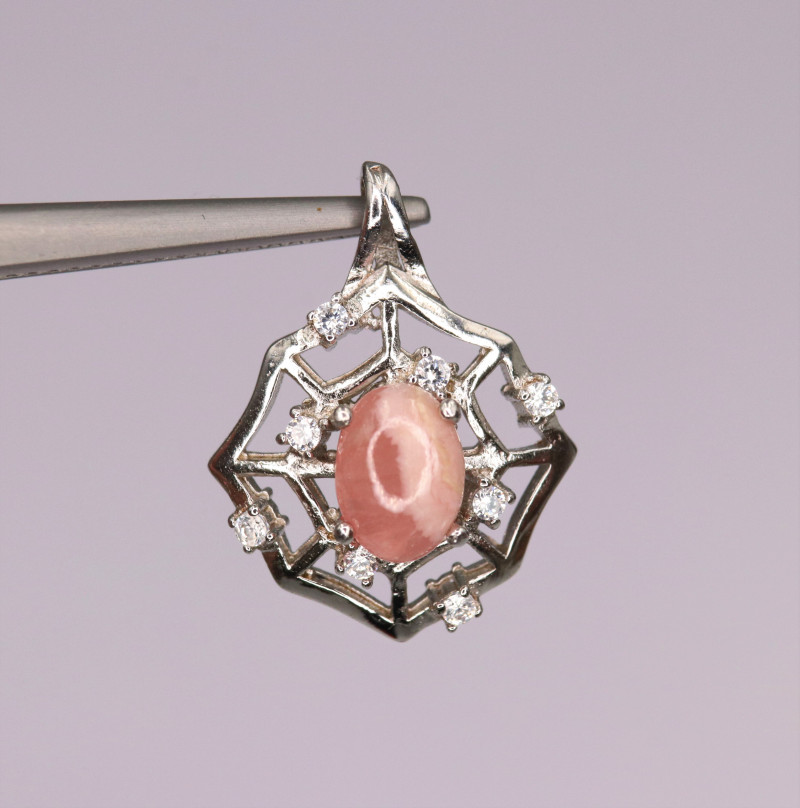 Image: Rhodochrosite pendant with cubic zirconia
Image: Rhodochrosite pendant with cubic zirconia
Rhodochrosite vs. Rhodonite Price
First, let’s look at rhodonite. How much does rhodonite cost?
The price range for rhodonite goes from $0.25-$1,000 per carat. Why is rhodonite so expensive? High-quality, facetable rhodonite crystals are rare.
The best rhodonite gemstones are transparent, inclusion-free, and deep crimson. These faceted gems can cost $150-$500 per carat if they’re under 10 carats. Over 10 carats and you’re looking at $500-$1,000 per carat.
But don’t fret! There are plenty of affordable rhodonite options. Opaque, banded rhodonite is usually just $0.25-$2 per carat.
Now, how much is rhodochrosite worth per carat?
Rhodochrosite prices range from $2-$1,000 per carat. Why is rhodochrosite so expensive? Like rhodonite, high-quality rhodochrosite crystals are rare. Gems with transparency, lack of yellow or brown hues, and medium shades will fetch high prices.
The most valuable rhodochrosite gems come from Colorado, USA. These can fetch prices of $500-$1,000 per carat.
Medium red-orange rhodochrosite is the next most valuable at $400-$450 per carat. Medium red or pink, transparent rhodochrosite gems cost roughly $350 per carat. Pale pink gems are $200-$250 per carat.
Also like rhodonite, opaque and banded rhodochrosite is much more affordable. When cut into a cabochon or beads for a rhodochrosite bracelet, the price is only $1-$5 per carat.
Outside of monetary value, spiritual benefits are also a major buying factor. Find out rhodochrosite and rhodonite’s healing properties and meanings next!
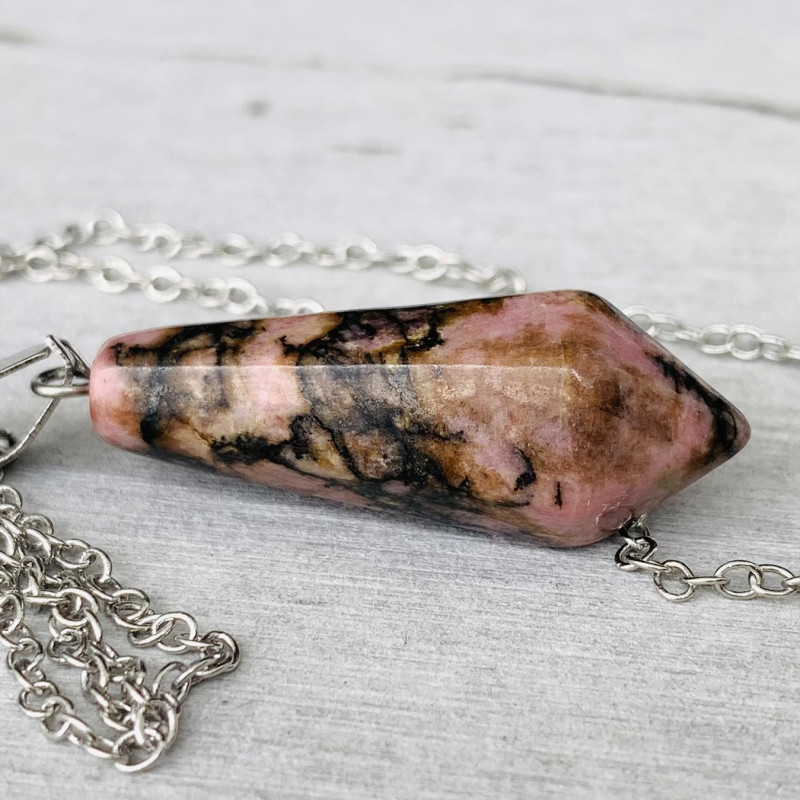 Image: Rhodonite pendant necklace
Image: Rhodonite pendant necklace
Rhodonite vs. Rhodochrosite Healing Properties
Both rhodonite vs. rhodochrosite symbolize love, compassion, and purpose. Rhodochrosite also represents nurturing and innocence. What does rhodonite symbolize? Individually, rhodonite symbolizes tolerance, generosity, and humanitarian causes.
Rhodochrosite’s spiritual meaning ties to its “Inca Rose” nickname. The ancient Inca society believed the pinkish-red stone held the blood of previous, deceased royals.
Similarly, rhodonite’s spiritual meaning ties to one location in particular: Russia. A historical tradition in some parts of Russia was placing rhodonite stones in baby’s cribs for soothing and protection.
Healing Uses
Speaking of, what are the benefits of rhodonite stone? Crystal healers recommend rhodonite healing stones for finding your purpose and helping you hone your talents toward that goal.
What are rhodochrosite’s benefits? Rhodochrosite crystals are said to support emotional healing from past grief or heartache. Plus, they can help you recognize the best qualities in yourself and others.
Chakra Healing
Rhodochrosite and rhodonite are both chakra stones for the heart chakra.
The seven chakras are energy points along your body that help your mind and body function. If one is blocked, negative side effects can arise, so chakra stones bring it back into balance.
When the heart chakra is blocked, you may feel apathetic, isolated, or unworthy of real love. Using one of these chakra stones to open it creates feelings of openness, compassion, and harmony.

Rhodonite vs. Rhodochrosite: Which Rhod is Right For You?
With that, you’re ready to tell any rhodonite and rhodochrosite apart! More importantly, you have the knowledge you need to buy the perfect rhodonite or rhodochrosite gemstone for you.
Don’t want to pick a favorite? Put rhodochrosite and rhodonite together in some mixed-stone jewelry or place both in your room and let their pink, soothing energies fill you with love.
Want to explore these gems more? Browse our rhodonite and rhodochrosite gemstone collections today!
Search the Gemstone Encyclopedia
Related Auctions
Related Articles
There are dozens of quartz and chalcedony gems with various colors and patterns. Learn all about quartz properties and every type of quartz, from amethyst and agate to plasma and phantom quartz!
15th Oct 2020
Let us explain how to buy gems on the internet. We have the largest range of gemstones on the internet and it can be a little overwhelming at first. Let us help you with some useful tips.
3rd Oct 2018
Have you ever wondered how they treat Ruby gemstones? There are so many different types of treatments on the market and we will help to explain them
9th May 2018
Latest Articles
Kurnakovite is a colorless crystal related to inderite and rarely faceted but known among collectors. Explore the mineral traits, history, prices, and more in this kurnakovite guide.
17th Feb 2025
Prosopite is an uncommon gemstone known for its rare robin’s egg blue form used for cabochons. Discover the history, benefits, prices, and powers of prosopite gemstones!
3rd Feb 2025
Stibiotantalite is a rare tantalum mineral sometimes found as stunning yellow to orange gems. Discover the history, properties, prices, and uses of stibiotantalite gemstones in this complete guide.
21st Jan 2025
Article Categories
How To's is where you will find helpful articles from gem Rock Auctions on how to cut gemstones, select gemstones and buy gemstones.
9 Articles






